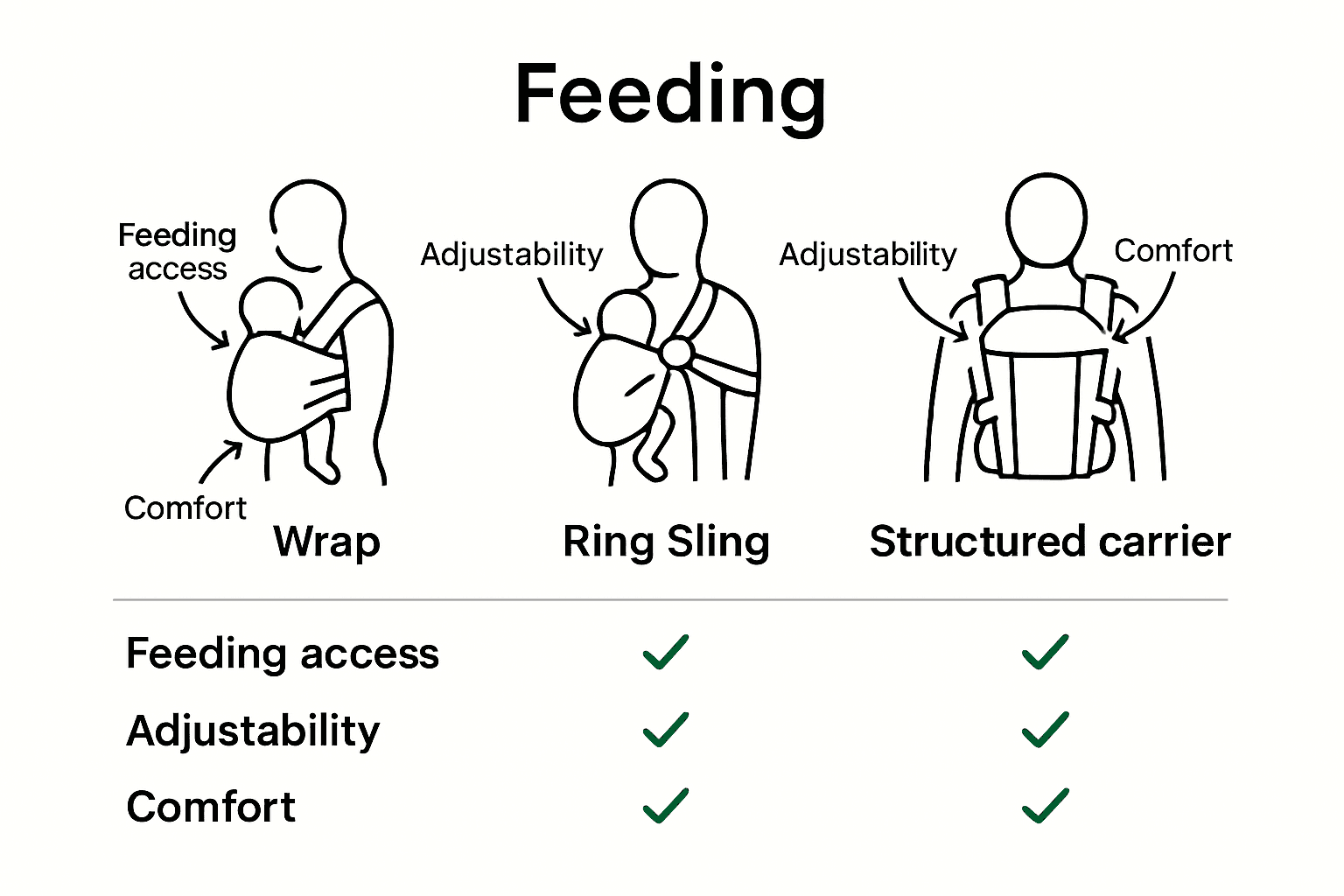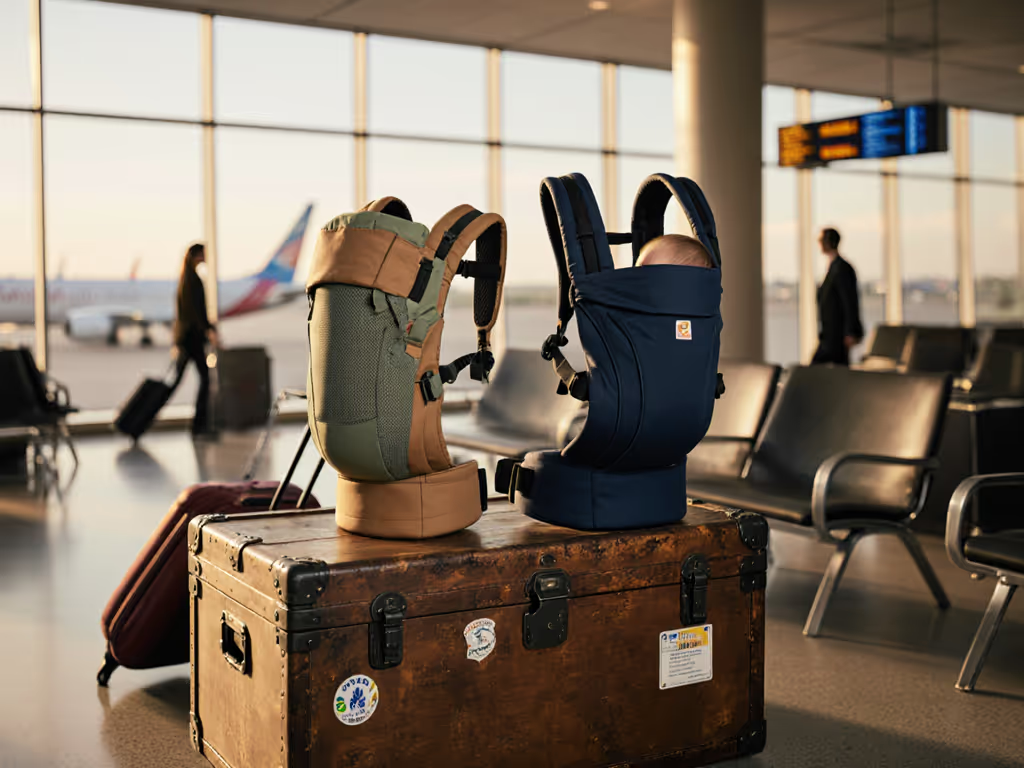
Complete Guide to the Role of Babywearing in Feeding

Over 80 percent of parents report feeling more connected to their infants through babywearing. This simple practice can reshape feeding routines, making it easier to spot hunger cues and respond before fussiness starts. Babywearing supports both emotional bonding and effective nutrition, setting the stage for positive daily rhythms. If you are curious how to use carriers for smoother feeds and deeper closeness, you will soon see just why more families rely on this hands-on approach.
Key Takeaways
| Point | Details |
|---|---|
| Enhanced Feeding Experience | Babywearing facilitates responsive feeding interactions, helping parents quickly recognize infant hunger cues and fostering maternal bonding. |
| Carrier Selection Matters | Choosing the right carrier type can significantly affect feeding comfort and infant positioning, influencing overall feeding success. |
| Safety Guidelines are Essential | Adhering to safety protocols regarding airway protection and proper positioning is crucial to prevent developmental complications during babywearing. |
| Overcoming Common Challenges | Parents should be aware of common mistakes and take time to adapt to babywearing practices, improving both comfort and efficiency in feeding routines. |
Defining Babywearing in Infant Feeding
Babywearing represents a powerful parenting practice that goes far beyond simple infant transportation. At its core, this approach involves carrying your baby close to your body using specialized fabric carriers, creating an intimate environment that supports multiple aspects of early childhood development and maternal bonding.
When it comes to infant feeding, babywearing offers unique advantages that transform traditional feeding experiences. Research from the Cleveland Clinic highlights how keeping an infant proximally close enables mothers to become more responsive to early feeding cues. This proximity allows caregivers to recognize hunger signals more quickly, facilitating more efficient and intuitive feeding interactions. The close contact also promotes skin-to-skin connection, which can help regulate infant body temperature and support breastfeeding success.
The physiological and emotional benefits of babywearing during feeding extend beyond immediate nutritional needs. A pivotal study published in PubMed examining maternal behaviors reveals that babywearing enhances maternal responsiveness, creating a more synchronized interaction between caregiver and infant. This synchronization is particularly critical during feeding times, where subtle body language and emotional attunement play significant roles in establishing healthy nutritional patterns.
Key characteristics of effective babywearing for feeding include:
- Maintaining an upright position that supports proper infant neck and spine alignment
- Ensuring carrier fabric allows easy breast or bottle access
- Providing sufficient support for infant head and neck
- Creating a calm, secure environment that reduces infant stress during feeding
By understanding babywearing as more than a convenience technique, parents can leverage this practice as a comprehensive approach to infant care that seamlessly integrates nutrition, emotional bonding, and developmental support.
Types of Carriers for Feeding Support
Choosing the right carrier type is crucial for successfully integrating babywearing into feeding routines. Different carrier designs offer unique advantages that can significantly impact maternal comfort, infant positioning, and overall feeding experience. Understanding the nuanced characteristics of each carrier style helps parents make informed decisions that support their specific needs.
Three primary carrier categories emerge as particularly supportive for feeding interactions: wrap carriers, ring slings, and soft structured carriers. Wrap carriers provide the most versatile and adaptable positioning, allowing mothers to create multiple breastfeeding configurations by adjusting fabric tension and placement. These long, stretchy fabrics distribute infant weight evenly and create an almost custom-fitted carrying experience that can seamlessly transition between feeding and other activities.
Ring slings represent another excellent option for feeding-focused babywearing. Their asymmetrical design allows quick adjustments and provides immediate breast access with minimal fabric repositioning. The Cleveland Clinic emphasizes that these carriers excel at supporting infant positioning while maintaining maternal mobility. Soft structured carriers, typically featuring padded waistbands and buckle systems, offer more rigid support and work exceptionally well for parents seeking structured infant positioning during feeding times.
Key considerations when selecting a carrier for feeding support include:
- Weight distribution across caregiver's body
- Fabric stretch and adaptability
- Ease of breast or bottle access
- Infant spine and neck support
- Comfort during extended wearing periods
- Compatibility with different body types
By carefully evaluating these factors, parents can select a carrier that not only facilitates feeding but also promotes a comfortable, intimate bonding experience that supports both infant nutrition and emotional connection.


How Babywearing Assists Breastfeeding and Bottle-Feeding
Babywearing transforms feeding experiences by creating an intimate, responsive environment that supports both breastfeeding and bottle-feeding methods. This innovative approach goes beyond traditional feeding techniques, offering parents a dynamic strategy for nurturing their infants while maintaining personal mobility and comfort.
For breastfeeding mothers, babywearing provides unprecedented advantages in responsiveness and convenience. Research published in PubMed demonstrates that close physical proximity increases maternal sensitivity to infant hunger cues, enabling quicker and more intuitive feeding responses. Skin-to-skin contact facilitated by carriers helps stimulate oxytocin production, which can enhance milk letdown and support breastfeeding success. The Cleveland Clinic emphasizes that carriers allow mothers to nurse discreetly, providing a sense of privacy and flexibility in various social settings.
Bottle-feeding parents also benefit significantly from babywearing techniques. The carriers' design allows for hands-free feeding, creating opportunities for multitasking while maintaining crucial physical and emotional connection with the infant. This approach supports consistent infant positioning, reduces strain on the caregiver's arms, and promotes a calm feeding environment that can minimize potential feeding-related stress for both parent and child.
Key benefits of babywearing during feeding include:
- Enhanced maternal-infant bonding
- Improved feeding cue recognition
- Increased feeding comfort and convenience
- Reduced physical strain during feeding
- Support for consistent infant positioning
- Flexibility in feeding locations and environments
By integrating babywearing into feeding routines, parents can create a more responsive, comfortable, and emotionally connected nutritional experience that supports infant development and caregiver well-being.
Key Safety and Positioning Guidelines
Infant safety remains the paramount concern when integrating babywearing into feeding routines. The intricate balance between maintaining close physical contact and ensuring proper positioning demands careful attention and consistent adherence to evidence-based guidelines that protect an infant's delicate physiological systems.
The Cleveland Clinic emphasizes three critical safety considerations that parents must prioritize: airway protection, spine alignment, and hip positioning. Proper carrier placement ensures the infant's face remains visible and unobstructed, with their chin off their chest to maintain an open airway. Research indicates that an infant's head should be positioned high enough to kiss, creating a natural angle that prevents respiratory compromise while supporting optimal breathing during feeding and carrying.
Specific positioning techniques are crucial for preventing potential developmental complications. Maintaining a physiological squat position is essential for infants, with their knees positioned higher than their bottom and legs spread in an "M" shape. This positioning supports natural hip development and reduces the risk of hip dysplasia. During feeding, carriers should allow easy breast or bottle access while maintaining this ergonomic stance, ensuring the infant remains securely supported without unnecessary strain on their developing musculoskeletal system.
Critical safety guidelines for babywearing include:
- Ensure infant's airways remain clear and unobstructed
- Maintain a visible face with chin off chest
- Support natural "M" shaped leg positioning
- Check carrier fabric tension regularly
- Verify infant's head and neck have adequate support
- Monitor infant's temperature and comfort
By integrating these meticulous safety protocols, parents can confidently embrace babywearing as a nurturing practice that prioritizes infant well-being while facilitating intimate feeding experiences.
Common Challenges and Mistakes to Avoid
Babywearing presents a learning curve that can overwhelm even the most dedicated parents. Understanding common pitfalls is crucial for creating a safe, comfortable experience that supports both caregiver and infant during feeding and daily activities. The journey involves navigating technical challenges and developing intuitive skills that may not come naturally at first.
According to research from the Cleveland Clinic, one of the most prevalent mistakes involves improper carrier positioning. Parents frequently struggle with incorrect fabric tension, which can compromise infant safety and comfort. Typical errors include placing the baby too low on the body, failing to support the infant's spine adequately, or creating carrier configurations that obstruct the baby's airway. These positioning mistakes can significantly impact feeding efficiency and infant well-being, potentially causing unnecessary stress for both caregiver and child.
Another critical challenge emerges in maternal adaptation to babywearing techniques. Research published in PubMed highlights that successful babywearing requires developing heightened sensitivity to infant cues, especially during feeding times. Many parents initially find it challenging to recognize subtle hunger signals while maintaining proper carrier positioning. This learning process demands patience, practice, and a willingness to adjust techniques based on individual infant needs and carrier characteristics.
Key challenges and potential solutions include:
- Recognize and correct carrier fabric tension
- Practice proper infant positioning techniques
- Develop sensitivity to infant feeding cues
- Learn multiple carrier configurations
- Understand individual infant comfort preferences
- Seek professional guidance when uncertain
By approaching babywearing as a skill to be learned and mastered, parents can transform initial challenges into confident, intuitive caregiving practices that support both nutritional needs and emotional bonding.
Enhance Your Babywearing Feeding Experience with Trusted Guidance
Babywearing during feeding offers incredible benefits but can also present challenges such as perfecting carrier positioning and staying responsive to your baby's subtle hunger cues. This article highlights key concerns like ensuring clear airways, supporting infant spine and hip alignment, and choosing the right carrier for comfort and feeding access. Many parents face these difficulties while striving to create a safe and nurturing feeding environment that promotes bonding and supports infant development.
At Caregiver Carry, we understand the delicate balance you need to achieve between safety and comfort. Our platform provides evidence-based guides and thorough reviews of baby carriers designed to fit your body type and lifestyle. Whether you want expert advice on wrap carriers, ring slings, or structured options that optimize feeding support, our resources help you make confident decisions. Discover step-by-step safety instructions to maintain proper infant positioning and ensure an unstrained feeding experience.
Ready to transform your feeding routine into a more connected and comfortable moment for you and your child? Visit Caregiver Carry now. Explore our detailed guides and carrier reviews to find the perfect solution for your unique needs. Take the first step toward safer, easier, and more nurturing babywearing feeding today.
Frequently Asked Questions
What are the benefits of babywearing during feeding?
Babywearing enhances maternal-infant bonding, improves recognition of feeding cues, increases convenience, reduces physical strain, and creates a calm feeding environment for both parents and infants.
What types of carriers are best for feeding?
Wrap carriers, ring slings, and soft structured carriers are the most supportive for feeding. They provide various benefits such as proper positioning, ease of access for breastfeeding or bottle-feeding, and comfort for the caregiver.
How do I ensure my baby is safely positioned while babywearing?
To ensure safety, the baby’s airway should be clear and visible, the chin should be off the chest, and the legs should be in an 'M' shape. It's important to check the fabric tension regularly and provide adequate head and neck support.
What common mistakes should I avoid when babywearing for feeding?
Common mistakes include improper carrier positioning, neglecting to support the infant's spine, and failing to recognize subtle hunger cues. It's important to practice proper techniques and adjust based on the baby's comfort and needs.



